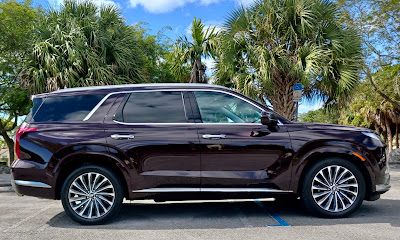LOOKING FOR A LUXURY SUV WITH NON-LUXURY PRICES? CHECK OUT THE PALISADE
Hyundai is not usually a brand you think of when the subject of luxury vehicles comes up but the top trims of the 2024 Hyundai Palisade may just change your thinking a bit.
The interior of the 2024 Hyundai Palisade Calligraphy is not only roomy but features styling touches that give the cabin the look and feel of a vehicle priced thousands of dollars higher.
Tech features are not only generous but are easy to operate off a 12.3-inch touchscreen with navigation. No need to take a deep dive to select your drive mode. Simply spin a dial on the center console to select Comfort, Eco, Sport, or Smart mode.
Smart — not to be confused with Smart (adaptive) Cruise Control —eliminates the need to make adjustments on the fly. When in Smart mode and pressing the accelerator pedal to make a pass, you get the extra power from Sport automatically. Revert to cruising through the neighborhood and you automatically fall back to Comfort or Eco mode. Snow/tow mode also is available on all-wheel-drive Palisades.
The Palisade was first shown at the 2018 Los Angeles Auto Show and was shipped to showrooms as a 2020 model. It is the South Korean automaker’s largest vehicle yet with three rows of seating that accommodate seven or eight passengers (depending on whether bench seats or captain’s chairs are used for the second row).
The Calligraphy trim was added in 2021, and a special Calligraphy Night Edition that features unique black wheels and black accents throughout the exterior is new for 2024
This review is based on the 2024 Hyundai Palisade Calligraphy with AWD that carries a starting MSRP of $53,435 including the destination and delivery fee. The Calligraphy Night Edition ups that to $55,245. That’s a pretty hefty jump from the $38,045 for the entry level SE trim with front-wheel drive but the comprehensive list of standard features eliminates the need for optional packages unless you really want to trick out your vehicle.
The Palisade is also offered in SEL, XRT, and Limited trims with either front-wheel or all-wheel drive.
All Palisades come with a 3.8-liter V6 engine mated to an 8-speed automatic transmission with manual gear selection capability. Fuel economy is so-so for the segment (19 miles-per-gallon city, 24 highway, and 21 combined) and power is adequate for everyday driving (291 ponies, 262 pound-feet of torque).resulting in sub-7 second) zero-to-60 mph times.
Standard goodies on the 2024 Hyundai Palisade Calligraphy include 20-inch alloy wheels; roof side rails, and LED headlights, taillights, and daytime running lights.
Comfort and convenience features Smart (adaptive) cruise control, a 12.-inch instrument cluster, a head-up display, dual automatic temperature control, digital rear-view mirror, keyless entry and push-button start, Nappa leather seating surfaces. a memory function for the driver’s seat, power third-row seats, second-row captain’s chairs, ventilated front and second-row seats, heated seats in all three row, hands-free power liftgate, and USB ports for all three rows.
Android Auto and Apple CarPlay, a Harman-Kardon premium sound system, a wi-fi hotspot, Hyundai’s BlueLink communications, and wireless phone charger are among standard tech features.
A surround-view monitor heads the list of safety features. Other safety systems include lane-keeping and lane-following assist, blind-spot warning, forward collision avoidance assist, driver attention warning, blind-spot view monitor (activated by the turn signals), parking distance warning, rear cross-traffic collision avoidance assist.
The Hyundai Palisade gets a new trim level (SEL Premium) and minor updates to features on the 2025 model.
My test 2024 Hyundai Palisade Calligraphy did get one extra item. Carpeted floor mats added $215 to run the final total to $53,650.
What I liked about the 2024 Hyundai Palisade Calligraphy: The plush, attractive interior is simply gorgeous and further blurs the line between luxury and non-luxury vehicles. The Calligraphy offers a long list of standard equipment and you can work through infotainment features without requiring IT training. There are knobs to adjust audio volume as well as surf the radio dial! The 18 cubic feet of cargo area behind the third row handles most routine tasks. Fold the third row and capacity opens up to 45.8 cubic feet. Safety ratings are excellent with the Insurance Institute for Highway Safety making the 2024 Palisade a Top Safety Pick.
What I didn’t like about the 2024 Hyundai Palisade Calligraphy: It’s a bit on the thirsty side. The cabin overall is roomy, but young kids won’t take long to outgrow the far back third row.
Would I buy the 2024 Hyundai Palisade Calligraphy? I have no need or desire for a three-row SUV but any family that wants to avoid settling for a minivan should take a long look at the Palisade. The higher trims challenge luxury class options.


























































